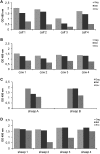Similar patterns of infection with bovine foamy virus in experimentally inoculated calves and sheep
- PMID: 23325680
- PMCID: PMC3592159
- DOI: 10.1128/JVI.02447-12
Similar patterns of infection with bovine foamy virus in experimentally inoculated calves and sheep
Abstract
Foamy viruses (FVs) are the least known retroviruses commonly found in primates, cats, horses, and cattle. Although FVs are considered apathogenic, simian and feline FVs have been shown to be associated with some transient health abnormalities in animal models. Currently, data regarding the course of infection with bovine FV (BFV) are not available. In this study, we conducted experimental infections of natural (cattle) and heterologous (sheep) hosts with the BFV(100) isolate and monitored infection patterns in both hosts during the early phase postinoculation as well as after long-term infection. Four calves and six sheep inoculated with BFV(100) showed no signs of pathology but developed persistent infection, as confirmed by virus rescue, consistent detection of BFV-specific antibodies, and presence of viral DNA. In both hosts, antibodies against BFV Gag and Bet appeared early after infection and persisted at high and stable levels while seroreactivity toward Env was consistently detectable only in BFV-infected sheep. Interestingly, the BFV proviral DNA load was highest in lung, spleen, and liver and moderate in leukocytes, while salivary glands contained either low or undetectable DNA loads in calves or sheep, respectively. Additionally, comparison of partial BFV sequences from inoculum and infected animals demonstrated very limited changes after long-term infection in the heterologous host, clearly less than those found in BFV field isolates. The persistence of BFV infection in both hosts suggests full replication competence of the BFV(100) isolate with no requirement of genetic adaptation for productive replication in the authentic and even in a heterologous host.
Figures





Similar articles
-
Bovine Foamy Virus: Shared and Unique Molecular Features In Vitro and In Vivo.Viruses. 2019 Nov 21;11(12):1084. doi: 10.3390/v11121084. Viruses. 2019. PMID: 31766538 Free PMC article. Review.
-
Serological detection systems for identification of cows shedding bovine foamy virus via milk.Virology. 2007 Jul 20;364(1):123-31. doi: 10.1016/j.virol.2007.03.009. Epub 2007 Apr 3. Virology. 2007. PMID: 17408715
-
Survey of bovine foamy virus infection among cattle in Japan and comparison with bovine leukemia virus infection.J Vet Med Sci. 2020 May 20;82(5):615-618. doi: 10.1292/jvms.19-0592. Epub 2020 Mar 20. J Vet Med Sci. 2020. PMID: 32201403 Free PMC article.
-
Infection with Foamy Virus in Wild Ruminants-Evidence for a New Virus Reservoir?Viruses. 2020 Jan 3;12(1):58. doi: 10.3390/v12010058. Viruses. 2020. PMID: 31947727 Free PMC article.
-
Non-primate foamy viruses.Curr Top Microbiol Immunol. 2003;277:197-211. doi: 10.1007/978-3-642-55701-9_9. Curr Top Microbiol Immunol. 2003. PMID: 12908774 Review.
Cited by
-
Bovine Foamy Virus: Shared and Unique Molecular Features In Vitro and In Vivo.Viruses. 2019 Nov 21;11(12):1084. doi: 10.3390/v11121084. Viruses. 2019. PMID: 31766538 Free PMC article. Review.
-
Foamy Viruses, Bet, and APOBEC3 Restriction.Viruses. 2021 Mar 18;13(3):504. doi: 10.3390/v13030504. Viruses. 2021. PMID: 33803830 Free PMC article. Review.
-
Seroprevalence of Feline Foamy Virus in Domestic Cats in Poland.J Vet Res. 2021 Oct 29;65(4):407-413. doi: 10.2478/jvetres-2021-0059. eCollection 2021 Dec. J Vet Res. 2021. PMID: 35111993 Free PMC article.
-
Functional Analyses of Bovine Foamy Virus-Encoded miRNAs Reveal the Importance of a Defined miRNA for Virus Replication and Host-Virus Interaction.Viruses. 2020 Nov 2;12(11):1250. doi: 10.3390/v12111250. Viruses. 2020. PMID: 33147813 Free PMC article.
-
Identification and functional characterization of Bet protein as a negative regulator of BFV3026 replication.Virus Genes. 2014 Jun;48(3):464-73. doi: 10.1007/s11262-014-1052-1. Epub 2014 Mar 11. Virus Genes. 2014. PMID: 24615636
References
-
- Saïb A. 2003. Non-primate foamy viruses. Curr. Top. Microbiol. Immunol. 277:197–211 - PubMed
-
- Switzer WM, Salemi M, Shanmugam V, Gao F, Cong ME, Kuiken C, Bhullar V, Beer BE, Vallet D, Gautier-Hion A, Tooze Z, Villinger F, Holmes EC, Heneine W. 2005. Ancient co-speciation of simian foamy viruses and primates. Nature 434:376–380 - PubMed
-
- Wolfe ND, Switzer WM, Carr JK, Bhullar VB, Shanmugam V, Tamoufe U, Prosser AT, Torimiro JN, Wright A, Mpoudi-Ngole E, McCutchan FE, Birx DL, Folks TM, Burke DS, Heneine W. 2004. Naturally acquired simian retrovirus infections in central African hunters. Lancet 363:932–937 - PubMed
Publication types
MeSH terms
Substances
Associated data
- Actions
- Actions
- Actions
- Actions
- Actions
- Actions
- Actions
- Actions
- Actions
- Actions
- Actions
- Actions
LinkOut - more resources
Full Text Sources
Other Literature Sources
Miscellaneous

